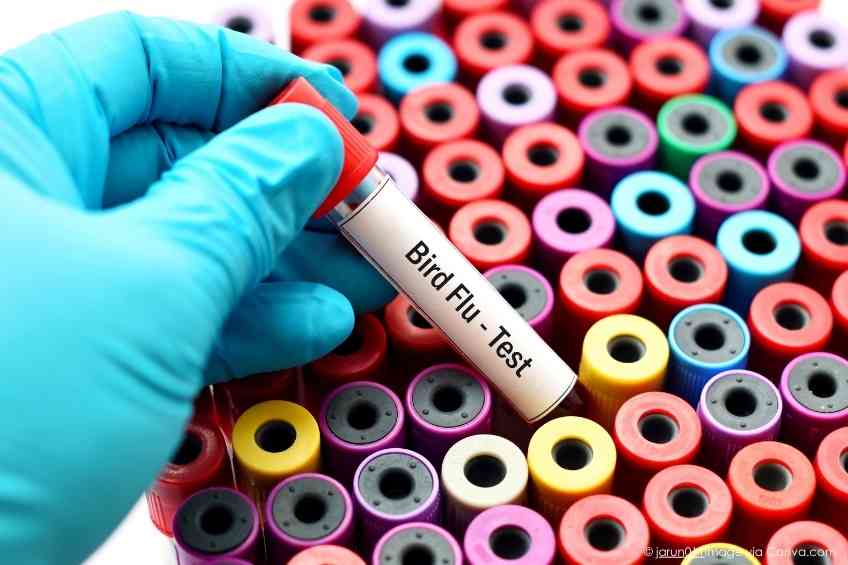By Jessica Scarpati –
Poultry and dairy farms have become ground zero for the latest outbreak of bird flu, also known as H5N1 avian influenza. It’s the Old McDonald’s Farm no one asked for—and now it’s spread to humans and drawing lots of media attention.
Is the media hype reflective of the danger? It’s a bit unclear. As of the end of July, public health experts report that known infections are limited to 13 farm workers in direct contact with infected chickens and cows. These are certainly not pandemic-like numbers.
The U.S. Food & Drug Administration (FDA) has also been trying to size up the potential problem. The FDA, for example, has been sampling commercial dairy products, finding that pasteurization kills off the virus, as does properly cooking beef and poultry products. And of the people who have tested positive for the virus, all cases have been relatively mild with flu-like symptoms.
But scientists who study viruses caution that this latest development―humans becoming infected with the latest variant of H5N1―is nothing to sneeze at.
“Every time you give an avian virus a chance to infect a human, it’s like buying a ticket for a lottery you don’t want to win,” Troy Sutton, PhD, a virologist at Penn State University, told NPR.
That’s because viruses mutate and adapt to their hosts. The fact that H5N1 is so widespread among cows is especially worrisome, as it signals the virus has mutated to become easier to spread to other animals. It’s further worrisome for people because they have a lot more in common, genetically speaking, with cows than birds.
So, while the individual risk is currently low unless you have backyard chickens or raise dairy cows, experts say a larger threat looms.
“I think the virus is clearly changing its property because we never saw outbreaks in cows,” said bird flu expert and virologist Yoshihiro Kawaoka, DVM, PhD, in an interview with The New York Times.
This particular variant of bird flu began appearing in wild birds a few years ago, followed by backyard and commercial chickens. Now it is present in bird populations across all 50 U.S. states. The H5N1 virus is also now found in more than 200 mammals, according to the U.S. Centers for Disease Control and Prevention (CDC). Scientists are worried pigs could be next, which would not bode well.
“[Pigs] have a lot of viruses circulating within them that are derived originally from human seasonal viruses,” U.K.-based virologist Tom Peacock, PhD, said in an interview with the CBC. “This is how pandemics happen: The mixing of seasonal viruses with avian viruses or novel viruses.”
Virologist Angela Rasmussen, PhD, a researcher at the University of Saskatchewan, went as far as to suggest that humans might even be in the eye of the storm.
“We are looking at, potentially, a huge outbreak that is still expanding, and still growing, and that is not containable,” she told CBC. “And that increases the risk of more and more human cases, which in turn increases the risk that this virus will become better adapted to humans.”
Another complicating factor: it is still not understood how bird flu is transmitted.
“We understand much less about H5N1 transmission than we do about COVID,” explained Yale Medicine infectious diseases expert Scott Roberts, MD.
This shorting is evident in the surprising discovery that some infected dairy workers developed conjunctivitis, also known as pink eye, as a symptom. Scientists have speculated that the infection occurred while workers were milking the cows and inadvertently sprayed some droplets in their exposed eyes. It’s theorized, too, that the virus has spread from cow to cow through shared milking equipment.
Additionally, in a study published this May in The New England Journal of Medicine, researchers reported that mice that were fed raw, unpasteurized milk became seriously ill. Beyond this, cats on several dairy farms became sick and died soon after consuming raw milk from infected cows.
It’s not just the virus itself sparking concern among public health experts; it’s also the slow response to the outbreak thus far. There is no commercially available test for bird flu, and while there is a vaccine for it, the U.S. has not manufactured enough doses to offer them at scale.
“It is crucial to avoid repeating mistakes from the COVID-19 pandemic, especially when dealing with H5N1, where the risks could be even greater due to its high mortality rate. Over the past 20 years, fatal outcomes have been reported in about 50 percent of known cases,” wrote pandemic expert Ayoade Alakija, MD, in an op-ed for Al Jazeera. “Investing in research and development that leads to quick, affordable tests for H5N1 influenza can lay the foundation for preparedness.”
Although the forecast sounds dire, there’s a significant bright spot: So far, there’s no evidence of human-to-human transmission of bird flu.
The CDC does have advice for those exposed to farm animals at work or home. The best way to evade infection is to wear personal protective equipment and avoid touching sick or dead birds, their feces or litter, or any surface or water source that might be contaminated with their bodily fluids.













